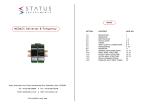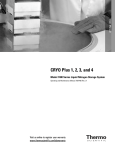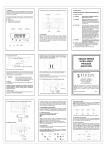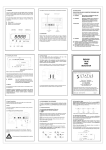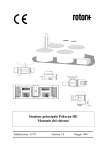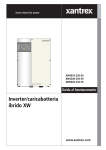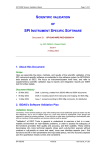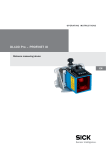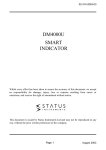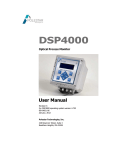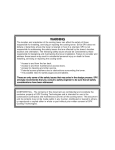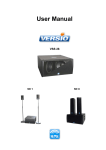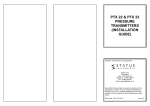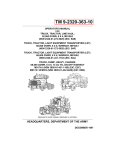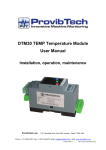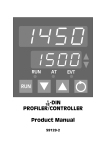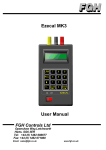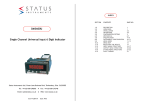Download MEDACS USER MANUAL - A1 Status Instruments
Transcript
MEDACS USER MANUAL (Universal Input Versions) XG9-5097-03 Page 1 of 45 Whilst every effort has been made to ensure the accuracy of this document, we accept no reponsibility for damage, injury, loss or expense resulting from errors or omissions, and reserve the right of amendment without notice. This document may not be repoduced in any way without prior written permission. XG9-5097-03 Page 2 of 45 Contents 1 1.1 INTRODUCTION .......................................................................................6 Description of Range ..............................................................................................................6 1.2 Installation ..............................................................................................................................7 1.2.1 Unpacking.........................................................................................................................7 1.2.2 Safety Information............................................................................................................7 1.2.3 Isolation ............................................................................................................................7 1.3 Input types...............................................................................................................................8 1.4 Output Types ..........................................................................................................................8 1.5 Input Output Variants ...........................................................................................................8 1.6 Configuration..........................................................................................................................9 2 SPECIFICATION .....................................................................................10 2.1 Inputs.....................................................................................................................................10 2.1.1 RTD ................................................................................................................................10 2.1.2 Thermocouple.................................................................................................................10 2.1.3 Current............................................................................................................................10 2.1.4 Voltage ...........................................................................................................................11 2.1.5 Digital inputs ..................................................................................................................11 2.2 Outputs ..................................................................................................................................12 2.2.1 Relays .............................................................................................................................12 2.2.2 Current Retransmission ..................................................................................................12 2.3 3 General ..................................................................................................................................12 ELECTRICAL CONNECTIONS...............................................................13 3.1 Power / Comms .....................................................................................................................13 3.2 Inputs.....................................................................................................................................14 3.3 Outputs ..................................................................................................................................15 4 MENU PROGRAMMING .........................................................................16 4.1 Operating Modes ..................................................................................................................16 4.2 Key Press Definitions............................................................................................................16 4.3 Entering Menu Mode ...........................................................................................................17 4.4 Root Menu.............................................................................................................................17 4.5 Navigating Around the Menu ..............................................................................................17 4.6 Entering a Sub-Menu ...........................................................................................................17 XG9-5097-03 Page 3 of 45 4.7 Editing a Parameter List......................................................................................................17 4.8 Editing a Number .................................................................................................................17 4.9 Menu Structures ...................................................................................................................18 5 MODBUS .................................................................................................20 5.1 Introduction ..........................................................................................................................20 5.2 MEDACS Configuration......................................................................................................20 5.3 Device addresses ...................................................................................................................21 5.3.1 Network Enable Passcode...............................................................................................21 5.4 Protocol Format....................................................................................................................21 5.5 5.5.1 MEDACS 2000 Modbus Functions .....................................................................................22 Function 3 Read Register................................................................................................22 5.6 Function 16 Write Register.................................................................................................. 23 5.7 Function 65 Request Slave ID..............................................................................................24 5.8 Modbus register allocation ..................................................................................................25 5.8.1 Input Parameters .............................................................................................................26 5.8.1.1 Universal Input ...........................................................................................................26 5.8.1.1.1 REGISTERS – CHANNEL 1...............................................................................26 5.8.1.1.2 REGISTERS – CHANNEL 2...............................................................................27 5.8.2 Output Parameters ..........................................................................................................28 5.8.2.1 Relay Output...............................................................................................................28 5.8.2.1.1 REGISTERS - CHANNEL 1................................................................................28 5.8.2.1.2 REGISTERS - CHANNEL 2................................................................................29 5.8.2.2 Current Output............................................................................................................30 5.8.2.2.1 REGISTERS – CHANNEL 1...............................................................................30 5.8.2.2.2 REGISTERS – CHANNEL 2...............................................................................31 5.8.3 Other Data ......................................................................................................................32 5.9 User Defined Area (UDA) Operation..................................................................................36 5.9.1 Interpolation ...................................................................................................................37 5.9.1.1 Interpolation Limits ....................................................................................................38 5.9.2 Segmented Polynomials..................................................................................................38 5.9.2.1 Polynomial Linearisation Limits ................................................................................39 5.9.3 Cold Junction Compensation..........................................................................................39 5.9.4 Interpolation Electrical Units..........................................................................................39 5.10 Modbus Register Notes ........................................................................................................40 5.10.1 Input status bitmap..........................................................................................................40 5.10.2 Alarm config bitmap.......................................................................................................40 5.10.3 Alarm state bitmap..........................................................................................................40 5.10.4 Relay state bitmap ..........................................................................................................40 5.10.5 Discrete map format .......................................................................................................40 5.10.6 General status bitmap .....................................................................................................40 5.10.7 Isolate word bitmap ........................................................................................................40 6 6.1 MEDACS FUNCTIONALITY....................................................................41 Input Scaling .........................................................................................................................41 XG9-5097-03 Page 4 of 45 6.1.1 6.1.2 6.1.3 6.1.4 6.1.5 6.1.6 6.1.7 RTD ................................................................................................................................41 Thermocouple.................................................................................................................41 Current / Voltage ............................................................................................................41 Out of Range Action.......................................................................................................42 Clear Function ................................................................................................................42 Edit Setpoints..................................................................................................................42 Discrete Inputs................................................................................................................42 6.2 Alarms / relays ......................................................................................................................43 6.2.1 Hysteresis .......................................................................................................................43 6.2.2 Deviation ........................................................................................................................43 6.2.3 Latched Alarms...............................................................................................................44 6.2.4 Closed-in-Alarm Type Relay – State Table....................................................................44 6.2.5 Changeover Type Relay - State Table ............................................................................44 6.3 Retransmitted Current Output ...........................................................................................44 6.4 Resetting MEDACS Configuration.....................................................................................45 6.4.1 General Configuration ....................................................................................................45 6.4.2 Input(s) Configuration ....................................................................................................45 6.4.3 Outputs Configuration ....................................................................................................45 XG9-5097-03 Page 5 of 45 1 1.1 Introduction Description of Range The MEDACS series consists of a range of DIN rail signal conditioning units. There are 2 different basic types available; single (21XX) or dual (22XX) input channel. MEDACS 21XX Single Input Channel Unit MEDACS 22XX Dual Input Channel Unit Both units are equipped with 2 output channels. On the 21XX units, both output channels are derived from the single input channel. On the 22XX units, output channel 1 is derived from input channel 1, and output channel 2 is derived from input channel 2. MEDACS units have powerful standard functions, which the user can easily configure via front panel display menu access, or via RS-485 Modbus communications. This standard functionality is explained in detail in this manual. MEDACS functionality can be greatly extended by the inclusion of TFML (Transfer Function Module Library). TFML was designed by Status to allow the user enhanced power and flexibility by providing a mechanism whereby each unit can be customised to perform a particular function. For standard functionality, the MEDACS user needs no knowledge of TFML. If the user wishes to use an existing TFML application, he/she should be aware of the functionality of the TFML module, but no knowledge/understanding of HOW the TFML was written is required. TFML modules are downloaded to MEDACS units using M-Config, Status’ PC-based configuration package. TFML modules are available for download from the Status website www.status.co.uk. If the user has a custom application which requires a new TFML, contact the distributor. This manual doesn’t detail the TFML functionality of the MEDACS units. XG9-5097-03 Page 6 of 45 1.2 Installation THIS SECTION FOR USE BY COMPETENT PERSONNEL ONLY Care must be taken when installing units into an enclosure to ensure that the ambient temperature range is not exceeded. Power supply units can produce heat and if possible are best mounted in a separate enclosure away from the Medacs units. Installation detail 1.2.1 Unpacking Please inspect the instrument carefully for any signs of shipping damage. The packaging has been designed to afford maximum protection, however, we cannot guarantee that mishandling will not have damaged the instrument. In the case of this unlikely event, please contact your supplier immediately and retain the packaging for subsequent inspection. 1.2.2 Safety Information WARNING The equipment must be installed by suitably qualified personnel and mounted in an enclosure providing protection to at least IP20. The equipment contains no user serviceable parts. 1.2.3 Isolation The 24V DC power supply and RS485 communications bus share the same common ground. Isolation is provided between input, output and supply/comms. The isolation voltage is 500V AC RMS, and has been flash tested to 1KV DC. XG9-5097-03 Page 7 of 45 1.3 Input types MEDACS units will accept the following input types: RTD, Thermocouple, Current (mA - passive or active), Voltage (mV or V). On 21XX units, there are 2 discrete inputs available. 1.4 Output Types Each of the 2 output channels is available in the following forms: Current retransmission Changeover relay Twin relay (2 normally relays per channel) 1.5 Input Output Variants The part number system adopts the following format: 2ABC Output channel 2 1 – Retransmitted current 2 – Changeover relay 3 – Twin NC relay Output channel 1 1 – Retransmitted current 2 – Changeover relay 3 – Twin NC relay Number of input channels 1 – Single channel input 2 – Dual channel input There are limitations on the input/output combinations available, as shown in the following table Part number 2122 2113 2133 2211 2222 2233 2213 XG9-5097-03 Number of input channels 1 1 1 2 2 2 2 Output channel 1 C/O relay Current Twin relay Current C/O relay Twin relay Current Output channel 2 C/O relay Twin relay Twin relay Current C/O relay Twin relay Twin relay Page 8 of 45 1.6 Configuration Each unit is equipped with RS485 Modbus serial communications. This enables any unit to be configured/monitored via comms. This manual documents the MEDACS Modbus implementation detail. With this information, the user may use any Modbus generic driver to communicate with a MEDACS unit. Status Instruments have written a Windows configuration package, called M-Config, which enables the user to quickly and easily communicate with MEDACS units without having an indepth knowledge of the Modbus implementation. (Note – for multi-drop communications, see the section 5.3.1, which describes the operation of the Network Enable Passcode). Whether configuring via comms or menu access, all configuration data is written directly to non-volatile memory. The 21XX units have the added advantage of local configuration via a menu structure accessible from the front panel keys/display. XG9-5097-03 Page 9 of 45 2 Specification 2.1 Inputs MEDACS units can accept the following input types. Input RTD Thermocouple Current Voltage 2.1.1 Ranges available Pt100, Ni120 K, J, T, R, S, E, F, N, B 4-20, ±20, ±10mA ±0.1, ±10, ±1, ±5, 1-5V RTD Sensor range Linearisation -200 to 850°C Pt100(BS EN 60751/JISC 1604)/Ni120/Custom 0.1°C ± 0.05% of reading ±0.004Ω/°C 100ppm /°C 300mA to 550mA 0.002 °C/Ω 50Ω/leg Basic accuracy Thermal drift (zero) Thermal drift (span) Excitation current: Lead resistance effect Max lead resistance 2.1.2 Thermocouple Type K J T R S E F N B Custom Range (°C) -200 TO 1370 -200 to 1200 -210 to 400 -10 to 1760 -10 to 1760 -200 to 1000 -100 to 600 -180 to 1300 -10 to 1650 user defined Basic accuracy: Linearisation: Cold juction error: Cold junction tracking: Cold junction range: Thermal drift (zero): Thermal drift (span): 2.1.3 ± 0.04% FS or ± 0.04% reading or ±0.5°C, whichever is greater (For type R & S, stated accuracy only applies between 800 & 1760°C) (For type B, stated accuracy only applies between 400 & 1650°C) BS4937 / IEC 584-3 / Custom ±0.5°C 0.05°C/°C -20 to 70°C ± 4µV/°C ± 200ppm /°C Current Range Accuracy Thermal drift Input impedance Linearisation XG9-5097-03 4-20mA, ±20mA, ±10mA 0.05% FS ± 0.05% of reading 200ppm/°C 20Ω Linear, Square root, Power 3/2, Power 5/2, Custom* Page 10 of 45 2.1.4 Voltage Range Accuracy Thermal drift Input impedance Linearisation ±100mV, ±1V, ±5V, ±10V, 1-5V 0.04%FS ±0.04% of reading 200ppm/°C 1MΩ Linear, Square root, Power 3/2, Power 5/2, Custom* * Custom linearisation available as interpolation or segmented polynomials. See section 5.9 for more details. 2.1.5 Digital inputs There are 2 digital inputs available on 21XX units; DIG1 & DIG2. These can be TTL, open collector, 24V dc logic or potential free contacts. DIG1 is used to perform reset/clear functions. It is also available for customised use with TFML. DIG2 is solely available for customised use with TFML. There are no digital inputs available on 22XX units. XG9-5097-03 Page 11 of 45 2.2 2.2.1 Outputs Relays Two relay options are available, either a single changeover or twin independent relays with normally closed contacts. Contacts are Normally Closed i.e the contact is open at power off and when operating in the absence of an alarm condition. The contact closes when an alarm is detected. The active function can be reversed in the software. Alarm Action Hysteresis Delay Time in order to be recognised) Start-up Delay Programmable Max switching voltage Max current Max power Contact resistance Operate time Electrical life @ full load Mechanical life AC 48V RMS 1A @48V 60VA <100mW <5ms 100,000 operations 10,000,000 operations 2.2.2 DC 48V 1A @ 30V 30W Current Retransmission Output Range Single Channel Dual Channel Maximum current output Accuracy Max power supply Temperature stability 2.3 Off, High, Low, Deviation, Test Programmable 0 to 100% Programmable (Alarm must be continuously present for this period 0-10, 0-20, 4-20 mA source or sink 4-20mA sink <23mA 0.07% or 5mA, whichever is greater 30V (In sink mode) 5mA/°C General EMC Approval: Immunity: Emmissions: Response Time Filter Power Requirements Isolation Ambient operating range Ambient storage Ambient humidity EMC emissions EMC immunity Display Range XG9-5097-03 EN61326: 1997 Annex A Industrial Class A 300mSec typical Programmable or Adaptive 24V DC ±10% @200 mA 500V AC I/P~O/P~PSU -30 to 60°C -50 to 85°C 10 to 90% RH BS EN50081-1 BS EN50082-2 -1999 to 9999 Page 12 of 45 3 Electrical Connections All connections are made to sockets which are removable for ease of maintenance. Installation should be undertaken in accordance with relevant sections of BS6739 - British Standards code of practice for "Instrumentation in Process Control Systems: Installation design and practice". 3.1 Power / Comms Medacs is provided with a unique ‘BUS JUMPER’ system for quick wiring of communications and power connections. To use the Bus Jumper, disconnect all power supply/communications connectors and place them so that they connect between the two units. Wiring to one connector then connects to all units. Note that the RX+/- terminals are used when in RS-485 2-wire mode. Ensure that the power supply is correct for the application. Over-voltage could damage the instrument. Ensure that the exposed section of the wire is fully inserted and that no loose strands are exposed. XG9-5097-03 Page 13 of 45 3.2 Inputs XG9-5097-03 Page 14 of 45 3.3 Outputs XG9-5097-03 Page 15 of 45 4 Menu Programming 4.1 Operating Modes All single channel MEDACS has 3 operating modes. These are: • • • Run Mode – Process Variable is displayed. Menu Mode – Enables navigation around menu structure. Edit Mode – Enables menu parameters to be edited. Run mode is the principal mode of operation. The other two modes are accessed as shown in the following diagram. Run mode ENTER then CYCLE ESCAPE Menu mode SHIFT ESCAPE or ENTER Edit mode 4.2 Key Press Definitions Each MEDACS unit has 3 keys (A, B & C) to enable menu programming. Each key pressed individually produces the following menu action (shaded square signifies key pressed): A B C CYCLE A B C SHIFT A B C INC Keys pressed simutaneously produce the following menu actions (shaded square signifies key pressed): XG9-5097-03 A B C ESCAPE A B C ENTER A B C CLEAR Page 16 of 45 4.3 Entering Menu Mode On power up, the unit(s) will take a few seconds to configure itself. Run mode will then automatically be entered. Menu mode is accessed from run mode by pressing ENTER followed by CYCLE. The user will then be able to move around the root menu. 4.4 4.5 Root Menu inPt out SYS Input Sub-menu Output Sub-menu System Sub-menu Navigating Around the Menu The user can navigate around the root menu (or any sub-menu) by pressing the CYCLE key. Menu navigation wraps around at the end of the menu list. The items displayed in the menu can either be submenus, parameter lists or numbers 4.6 Entering a Sub-Menu Pressing SHIFT enters the sub-menu or enables parameter list/number editing, depending on where the menu structure is currently being pointed. If the menu navigation is pointing at a sub-menu, the subsequent sub-menu can then be cycled around using the CYCLE key. 4.7 Editing a Parameter List A parameter is selected from a list of options. The parameter option list can be cycled through by pressing the INC key. The user will be able to distinguish between a menu cycle action, and a parameter list cycle action by having the following 2 dynamic display styles: Action Display Style Menu Cycle Parameter List Cycle Display scrolls on cycle press, no flash Flash display at 1Hz While the display is flashing, the option on the display has not been saved to memory. When the desired parameter option is in view, pressing the ENTER key will save it to memory. The display will stop flashing for 1 second to confirm the selection, before returning to the previous sub-menu. Waiting for 1 minute without a key press, or pressing the ESCAPE key will return the user to the previous submenu, without saving the selection. 4.8 Editing a Number A number is edited by incrementing each digit in turn. The user will know which digit is currently selected for incrementing by the flashing (@1Hz) of that digit. Pressing the INC key will increment the digit. On overflow, the digit will wrap around to ‘-‘ or ‘0’, whichever is applicable. Pressing SHIFT will shift the currently selected digit right one place. If the number is a whole number, pressing SHIFT when the right most digit is selected will wrap the selection around to the left most digit, and the process starts again. XG9-5097-03 Page 17 of 45 If the number is a floating point number, pressing SHIFT when the right most digit is selected will select the decimal point position as the editable parameter. In this case, pressing INC will shift the DP position one place to the right. If the current DP position is the right most, the DP will wrap around to the first DP position. Pressing SHIFT will select the left most digit as the editable parameter, and the process starts again. While the display is flashing, the number on the display has not been saved to memory. When the desired number is in view, pressing the ENTER key will save it to memory. The display will stop flashing for 1 second to confirm the saved number, before returning to the previous sub-menu. Waiting for 1 minute without a key press, or pressing the ESCAPE key will return the user to the previous submenu, without saving the number. 4.9 Menu Structures This following describes the menu tree structure through the use of a tree-diagram. The tree-diagram is explained in more detail in the MEDACS Installation guide. XG9-5097-03 Page 18 of 45 XG9-5097-03 Page 19 of 45 5 5.1 Modbus Introduction It is possible to communicate via MODBUS with products in the MEDACS range. Modbus is a Master-Slave based communications protocol. This means that all messages may only be initiated by the Master device. In general the Master will communicate with one Slave device at a time, although it is possible under certain circumstances for the Master to broadcast to the entire network. The MEDACS units are Slave devices and therefore require to be put on a network that has a Master in order to operate. This guide contains sufficient information in order to program and configure the Master Modbus device so that parameters from the MEDACS units may be accessed. 5.2 MEDACS Configuration When the unit is powered-up, there will be a communications menu available. There are three items to configure. Slave Baud rate (bAud) 19.2Kb, 9.6kB, 1.2kB available Mode (Line) 2 wire or 4 wire available Device Address (Addr) Network unique address 0-255 (Note that maximum device no. for MODBUS is 247) The comms port settings of 1 stop bit, 1 start bit, 8 data bits and no parity is fixed and therefore may not be changed. The baud rate should be set up for the network. Although it is theoretically possible to set different baud rates for different devices it is recommended that one baud rate is chosen throughout. The RS485 mode determines the way that the network is connected together. The 2-wire arrangement, shown below, has both transmit and receive signals sharing the same wires. Although this makes most efficient use of the connections and makes wiring simpler, correct operation depends upon critical timing within the Master device. A reply from a Slave device will occur about 5ms after the Master has issued a message, therefore, the Master output buffer needs to be disabled in time to prevent a data clash and a corrupted reply from the Slave. Master device Tx/Rx Modbus RS485 2 Wire mode Tx/Rx Tx/Rx Slave unit 1 Slave unit 2 Tx/Rx Slave unit 3 If 4-wire mode is chosen, the network is wired as shown below and does not have the same critical requirements for Master device message timing as the Master has dedicated transmit lines. XG9-5097-03 Page 20 of 45 Master device Modbus RS485 4 Wire mode Tx Rx Tx Rx Slave unit 1 5.3 Tx Rx Slave unit 2 Tx Rx Slave unit 3 Device addresses Each Slave unit requires a unique address to be programmed. If two or more units have the same address on the network, both or all will respond when this address is accessed by the Master device and a data corruption will result. Possible addresses range from 1-255; however, Modbus defines a maximum address number of 247. The electrical characteristics of RS485 limit the number of devices on a network to 32; however, buffering the network increases this number. 5.3.1 Network Enable Passcode Each MEDACS unit has a “unique ID” (UID) associated with it. There is a correct Network Enable Passcode (NEP) associated with each UID. A standard MEDACS unit will leave the factory with NEP set to 0, which is the incorrect NEP. When the correct NEP is set, the device address can be set to a non-zero value, thus enabling networked communications. Once the unique ID has been noted (using M-Config) contact the distributor to acquire the correct NEP. 5.4 Protocol Format MEDACS uses the RTU mode of transmission (as opposed to the ASCII mode). The basic Modbus RTU protocol format for both Master and Slaves is as follows: Slave Address Function Code Data Error Check The Slave address is as described above. The Function code defines the type of comms operation. The 3 user function codes supported are listed below. Function code 3 16 65 Description Read holding register(s) value Write register(s) value Request unit id The Data field is Function code dependent and is detailed in the following sections. The CRC (Cyclic Redundancy Check) is a 16 bit field transmitted alongside the message and is used to confirm its accuracy. The method of calculation of the CRC is contained in the Appendix to this document. XG9-5097-03 Page 21 of 45 5.5 MEDACS 2000 Modbus Functions 5.5.1 Function 3 Read Register The general format for the read registers request/reply sequence is as follows (each cell represents an eight bit byte): Request issued from Master. Slave Address 3 Start Addr High Start Addr Low No. Regs High No. Regs Low CRC Low CRC High The Start Addr High and Low make up a 16 bit register address word. Note that the index of the register allocation table is based from 1 whilst the value that is entered in the comms message is zero based. For example, the address of the Process Variable value stated as ‘1’ in the Register allocation table is entered as 0x0000 in the Modbus comms field. The Number of registers requested is limited to 8 due to comms buffer restrictions. Therefore the “No. Regs High” field is always set to zero. A single register represents a 16-bit data field and therefore in order to access a floating-point number, two consecutive registers need to be requested. The format of the number returned is IEEE 754 floating point format. It follows that the maximum number of floating point values that can be requested in a message of this type is limited to 4. Format of the reply from Slave. Slave Address 3 No. of Bytes Regn High value Regn Low value CRC Low CRC High The “No. Of Bytes” value represents the number of bytes of actual data returned. As each register is a 16-bit number, the number of bytes value is the number of registers requested times two. FUNCTION 3 EXAMPLE The first 3 registers are to be requested from a MEDACS addressed as device 6. Registers 1 & 2 together constitute an IEEE 754 32 bit floating point number representing the channel 1 process variable(PV). Register 3 is a stand-alone 16 bit register indicating the input type from a list of options. The following message is transmitted by the Master. Addr Funcn 6 3 Start Addr High 0 Start Addr Low 0 No. Regs High 0 No. Regs Low 3 CRC Low CRC High Although all Slave devices on the network ‘hear’ the message, only device 6 responds. Addr Funcn No. of Bytes 6 3 6 Regn High value 0x41 Regn Low value 0xC9 Regn+1 High value 0x00 Regn+1 Low value 0x00 Regn+2 High Value 0x00 Regn+2 Low value 0x01 CRC Low CRC High This indicates that: Process variable = 0x41C90000 = 25.125 Input type = 0x0001 (Thermocouple) XG9-5097-03 Page 22 of 45 5.6 Function 16 Write Register The general format for the write register request/reply sequence is as follows (each cell represents an eight bit byte): Request issued from Master. Slave Addr 16 Start Addr Start Addr No. High Low Regs High No. No. Regs Bytes Low Regn High value Regn Low value CRC CRC Low High The Start Addr High and Low make up a 16 bit register address word. Note that the index of the register allocation table is based from 1 whilst the value that is entered in the comms message is zero based. The Number of registers to be written to is limited to 8 due to comms buffer restrictions. Therefore the “No. Regs High” field is always set to zero. Format of the reply from Slave. Slave Address 16 Start Addr High Start Addr Low No. Regs High No. Regs Low CRC Low CRC High Function 16 will not write to registers 181-300 (inclusive). Function 16 Example The engineering_low value on device 111 (0x6F) is to be set to 20.0. The register address for this is 12; this corresponds to a zero based address of 11 (0x0b) for the comms command. Note that for consistency all the byte values are expressed in hexadecimal format. In IEEE 754 format, 20.0 = 0x41a00000. Addr Funcn 0x6F 0x10 Start Addr High 0x00 Start Addr Low 0x0b No. Regs High 0x00 No. Regs Low 0x02 No. of Bytes 0x04 Regn High value 0x41 Regn Low value 0xa0 Regn+1 High value 0x00 Regn+1 Low value 0x00 CRC Low After setting the engineering_low value to 20.0, device 111 sends the following message in way of acknowledgement. Addr Funcn 0x6F 0x10 XG9-5097-03 Start Addr High 0x00 Start Addr Low 0x0b No. Regs High 0 No. Regs Low 2 CRC Low CRC High Page 23 of 45 CRC High 5.7 Function 65 Request Slave ID This function is used by the Master to determine the identification of the Slave device. Request issued from Master. Slave Address 65 Code High Code Low CRC Low CRC High The Code High and Low fields are not used and should be set to zero. Format of the reply from Slave. Slave Address 65 No. of Bytes (9) Product Type Product Input 1 Option Product Product Product Input 2 Output 1 Output 2 Option Option Option S/W Issue 0 S/W Issue 1 S/W Issue 2 CRC Low The number of bytes reflects the number of data items in the reply and is set to 6. The product type codes are defined as follows: Product type code 1 2 3 4 Product type Dual channel transmitter Single channel transmitter Single channel indicator Gateway unit The Product input option codes reflect each channel’s input option. The input option codes are defined as follows. Product Input Option Code 0 1 2 Input Option None installed Universal temperature / process Frequency The Product output option codes reflect the output options available. The output option codes are defined as follows. Product Output Option Code 0 1 2 3 Output Option None installed Retransmission C/O relay Twin relay The three-byte software code represents the issue date of the instrument software, each nybble representing a BCD number. For example, the S/W issue code 0x12,0x09,0x00 represents 12/9/2000. XG9-5097-03 Page 24 of 45 CRC High 5.8 Modbus register allocation This section defines the Modbus allocation of the MEDACS system variables. Registers shown in grey are reserved and should not be accessed by the user. The register space between registers 61 & 120 describes the output configuration. These registers will depend upon what output option is fitted. XG9-5097-03 Page 25 of 45 5.8.1 Input Parameters The input can be current (I), voltage (V), RTD or thermocouple (TC). 5.8.1.1 5.8.1.1.1 Universal Input REGISTERS – CHANNEL 1 REG 1. 2. 3. 4. 5. 6. 7. 8. 9. 10. 11. 12. 13. 14. 15. 16. 17. 18. 19. 20. 21. 22. 23. 24. 25. 26. 27. 28. 29. 30. XG9-5097-03 DESCRIPTION FORMAT Process variable (HO) Process variable (LO) Input type Linearisation index (RTD) Linearisation index (TC) Linearisation index (I,V) Filter Factor (HO) Filter Factor (LO) User offset (HO) User offset (LO) Temperature units (RTD,TC) Input range (I) Input range (V) Float Engineering_low (HO) Engineering_low (LO) Engineering_high (HO) Engineering_high (LO) Units string 1 (HO) Units string 2 Units string 3 Tag string 1 (HO) Tag string 2 Tag string 3 Tag string 4 Input status Burnout config Integer List Integer List UNITS / LIST OPTIONS / RANGE °C, °F, Engineering units Float RTD, TC, I, V Pt100(Euro), Ni120, Pt100(JISC), Custom K,J,T,R,S,E,F,N,B Custom Linear, X1/2, X3/2, X5/2 ,Custom 0: adaptive, 0.3-99.9: time const, 0-0.3: off Engineering units Integer List °C, °F Integer List Integer List Float 4-20mA, ±20mA, ±10mA, ±100mV, ±10V, ±1V, ±5V, 15V Engineering units Float Engineering units 2 char ASCII 2 char ASCII 2 char ASCII 2 char ASCII 2 char ASCII 2 char ASCII 2 char ASCII Integer bitmap Integer list See note 5.10.1 Simulate high, low Integer List Integer List Float Page 26 of 45 5.8.1.1.2 REGISTERS – CHANNEL 2 (only applies to 22XX units ) REG DESCRIPTION 31. 32. 33. 34. 35. 36. 37. 38. 39. 40. 41. 42. 43. 44. 45. 46. 47. 48. 49. 50. 51. 52. 53. 54. 55. 56. 57. 58. 59. 60. XG9-5097-03 Process variable (HO) Process variable (LO) Input type Linearisation index (RTD) Linearisation index (TC) Linearisation index (I,V) Filter Factor (HO) Filter Factor (LO) User offset (HO) User offset (LO) Temperature units (RTD,TC) Input range (I) Input range (V) Engineering_low (HO) Engineering_low (LO) Engineering_high (HO) Engineering_high (LO) Units string 1 (HO) Units string 2 Units string 3 Tag string 1 (HO) Tag string 2 Tag string 3 Tag string 4 Input status Burnout config FORMAT Float Integer List Integer List UNITS / LIST OPTIONS / RANGE °C, °F, Engineering units Float RTD, TC, I, V Pt100(Euro), Ni120, Pt100(JISC), Custom K,J,T,R,S,E,F,N,B Custom Linear, X1/2, X3/2, X5/2 ,Custom 0: adaptive, 0.3-99.9: time const, 0-0.3: off Engineering units Integer List °C, °F Integer List Integer List Float 4-20mA, ±20mA, ±10mA, ±100mV, ±10V, ±1V, ±5V, 15V Engineering units Float Engineering units 2 char ASCII 2 char ASCII 2 char ASCII 2 char ASCII 2 char ASCII 2 char ASCII 2 char ASCII Integer bitmap Integer list See note 5.10.1 Simulate high, low Integer List Integer List Float Page 27 of 45 5.8.2 Output Parameters Register space is shared between relay output variables and current retransmission variables. For example, for a 2133 unit, registers 61 & 62 form the setpoint associated with alarm 1A. For a 2113 unit, register 61 is the retransmission status for current output channel 1. 5.8.2.1 5.8.2.1.1 Relay Output REGISTERS - CHANNEL 1 REG 61. 62. 63. 64. 65. 66. 67. 68. 69. 70. 71. 72. 73. 74. 75. 76. 77. 78. 79. 80. 81. 82. 83. 84. 85. 86. 87. 88. 89. 90. XG9-5097-03 DESCRIPTION FORMAT UNITS / OPTIONS / RANGE Setpoint A (HO) Setpoint A (LO) Hysteresis A (HO) Hysteresis A (LO) Deviation A (HO) Deviation A (LO) Delay A Alarm A action Alarm A config Float Engineering units Float Engineering units Float Engineering units Integer Integer list Integer bitmap Off, low, high, deviation, test See note 5.10.2 Float Engineering units Float Engineering units Float Engineering units Integer Integer list Integer bitmap Off, low, high, deviation, test See note 5.10.2 Setpoint B (HO) Setpoint B (LO) Hysteresis B (HO) Hysteresis B (LO) Deviation B (HO) Deviation B (LO) Delay B Alarm B action Alarm B config Page 28 of 45 5.8.2.1.2 REGISTERS - CHANNEL 2 REG 91. 92. 93. 94. 95. 96. 97. 98. 99. 100. 101. 102. 103. 104. 105. 106. 107. 108. 109. 110. 111. 112. 113. 114. 115. 116. 117. 118. 119. 120. XG9-5097-03 DESCRIPTION FORMAT UNITS / OPTIONS / RANGE Setpoint A (HO) Setpoint A (LO) Hysteresis A (HO) Hysteresis A (LO) Deviation A (HO) Deviation A (LO) Delay A Alarm A action Alarm A config Float Engineering units Float Engineering units Float Engineering units Integer Integer list Integer bitmap Off, low, high, deviation, test See note 2 Float Engineering units Float Engineering units Float Engineering units Integer Integer list Integer bitmap Off, low, high, deviation, test See note 2 Setpoint B (HO) Setpoint B (LO) Hysteresis B (HO) Hysteresis B (LO) Deviation B (HO) Deviation B (LO) Delay B Alarm B action Alarm B config Not allocated Not allocated Not allocated Not allocated Not allocated Not allocated Page 29 of 45 5.8.2.2 5.8.2.2.1 Current Output REGISTERS – CHANNEL 1 REG 61. 62. 63. 64. 65. 66. 67. 68. 69. 70. 71. 72. 73. 74. 75. 76. 77. 78. 79. 80. 81. 82. 83. 84. 85. 86. 87. 88. 89. 90. XG9-5097-03 DESCRIPTION FORMAT UNITS / OPTIONS / RANGE Retransmission status Retransmission low (HO) Retransmission low (LO) Retransmission high (HO) Retransmission high (LO) Preset level (HO) Preset level (LO) Retransmission type Not allocated Not allocated Not allocated Not allocated Not allocated Not allocated Not allocated Not allocated Not allocated Not allocated Not allocated Not allocated Not allocated Not allocated Not allocated Not allocated Not allocated Not allocated Not allocated Not allocated Not allocated Not allocated Integer list Float 4-20mA, 0-20mA, 0-10mA Engineering units Float Engineering units Float mA Integer list Retransmission, preset Page 30 of 45 5.8.2.2.2 REGISTERS – CHANNEL 2 REG 91. 92. 93. 94. 95. 96. 97. 98. 99. 100. 101. 102. 103. 104. 105. 106. 107. 108. 109. 110. 111. 112. 113. 114. 115. 116. 117. 118. 119. 120. XG9-5097-03 DESCRIPTION FORMAT UNITS / OPTIONS / RANGE Retransmission status Retransmission low (HO) Retransmission low (LO) Retransmission high (HO) Retransmission high (LO) Preset level (HO) Preset level (LO) Retransmission type Not allocated Not allocated Not allocated Not allocated Not allocated Not allocated Not allocated Not allocated Not allocated Not allocated Not allocated Not allocated Not allocated Not allocated Not allocated Not allocated Not allocated Not allocated Not allocated Not allocated Not allocated Not allocated Integer list Float 4-20mA, 0-20mA, 0-10mA Engineering units Float Engineering units Float mA Integer list Retransmission, preset Page 31 of 45 5.8.3 Other Data REG 121. 122. 123. 124. 125. 126. 127. 128. 129. 130. 131. 132. 133. 134. 135. 136. 137. 138. 139. 140. 141. 142. 143. 144. 145. 146. 147. 148. 149. 150. 151. 152. 153. 154. 155. 156. 157. 158. 159. 160. 161. 162. 163. 164. 165. 166. 167. 168. 169. 170. 171. 172. DESCRIPTION FORMAT O/P config 1 O/P config 2 Display resolution Menu passcode Modbus device number Comms baud rate Number of wires General status Integer list Integer list Integer list Integer Integer Integer list Integer list Integer bitmap UNITS / OPTIONS / RANGE none, rtx, c/o, twin none, rtx, c/o, twin 0,1,2,3 dec places 0 to 9999 0 to 247 19k2,9k6,1k2 baud 4 wire,2 wire See note 5.10.6 Output startup delay (HO) Output startup delay (LO) Ch1 peak (HO) Ch1 peak (LO) Ch1 valley (HO) Ch1 valley (LO) Float 5-3600 seconds Message (HO) Message Message Message Message Message Message Message Message Message Message Message Message Message Message Message (LO) Tag (HO) Tag Tag Tag (LO) Descriptor (HO) Descriptor Descriptor Descriptor Descriptor Descriptor Descriptor Descriptor (LO) Network enable password 32 char string XG9-5097-03 Float Float 8 char string 16 byte string Integer 0 to 9999 Page 32 of 45 173. 174. 175. 176. 177. 178. 179. 180. 181. 182. 183. 184. 185. 186. 187. 188. 189. 190. 191. 192. 193. 194. 195. 196. 197. 198. 199. 200. 201. 202. 203. 204. 205. 206. 207. 208. 209. 210. 211. 212. 213. 214. 215. 216. 217. 218. 219. 220. 221. 222. 223. 224. 225. 226. 227. 228. 8 char string S/W revision (HO) S/W revision S/W revision S/W revision (LO) Manufacture Date (HO) Manufacture Date (LO) Discrete map Integer bitmap Num secs since 01/01/2000 00:00 See note 5.10.5 Isolate word alarm state relay state Integer bitmap Integer bitmap Integer bitmap See note 5.10.7 See note 5.10.3 See note 5.10.4 CJ_temp (HO) CJ_temp (LO) Float °C current o/p retran level 1 (HO) current o/p retran level 1 (LO) Float mA current o/p retran level 2 (HO) current o/p retran level 2 (LO) Float mA XG9-5097-03 Long int Page 33 of 45 229. 230. 231. 232. 233. 234. 235. 236. 237. 238. 239. 240. 241. 242. 243. 244. 245. 246. 247. 248. 249. 250. 251. 252. 253. 254. 255. 256. 257. 258. 259. 260. 261. 262. 263. 264. 265. 266. 267. 268. 269. 270. 271. 272. 273. 274. 275. 276. 277. 278. 279. 280. 281. 282. 283. 284. XG9-5097-03 Page 34 of 45 285. 286. 287. 288. 289. 290. 291. 292. 293. 294. 295. 296. 297. 298. 299. 300. TFML_float_1 (HO) TFML_float_1 (LO) TFML_float_2 (HO) TFML_float_2 (LO) TFML_float_3 (HO) TFML_float_3 (LO) TFML_float_4 (HO) TFML_float_4 (LO) XG9-5097-03 Float Float Float Float Page 35 of 45 5.9 User Defined Area (UDA) Operation Vn denotes a floating point number. Modbus Address 301 302 303 Single chan unit Dual chan unit UDAID (zero) Order (0-interp, >0-poly) Segment (<=59) UDAID (zero) Order (0-interp, >0-poly) Segment (<=29) V1 V1-1 V2 V1-2 V60 V1-60 V61 CJ coefficient 1-A 304 305 306 Channel 1 307 422 423 424 425 426 V62 427 428 Order2 (0-interp, >0-poly) V63 429 Segment2 (<=29) 430 V64 V2-1 V65 V2-2 V120 V2-57 CJ coefficient A V2-58 431 432 Channel 2 433 542 543 544 545 546 V2-59 547 XG9-5097-03 Page 36 of 45 Modbus Address Single chan unit Dual chan unit 548 V2-60 549 550 CJ coefficient 2-A 551 The UDA is an area of non-volatile memory where either user-linearisation data, or TFML modules are stored. If a TFML module is loaded into the unit, the standard user-linearisation functions described in this section will be disabled. If a custom TFML is required which uses user-linearisation, the relevant data can be written into the TFML module. If the UDAID is set to 0, any TFML module loaded is paused. If the relevant linearisation index is set to the ’custom linearisation’ value, then user-linearisation will be performed. If ‘order’ is set to zero, interpolation is performed, otherwise polynomial linearisation is performed. For interpolation, ‘segments’ defines the number of interpolated segments to be used. For polynomial linearisation, ‘order’ defines the order of the polynomial to be applied. If ‘order’ is set to a value greater than 15, performance will be unpredictable. UDAID Order TFML 1 0 Segment 0 5.9.1 Polynomial 0 1 to 15 1 to 19 (dual chan) 1 to 39 (single chan) Interpolation 0 0 1 to 29 (dual chan) 1 to 59 (single chan) Interpolation For interpolation, numbers are entered into the UDA as follows: Order = 0 Segment = Number of interpolated segments = Number of co-ordinate pairs – 1. V1 = electrical input co-ordinate 1 V2 = PV co-ordinate 1 V3 = electrical input co-ordinate 2 V4 = PV co-ordinate 2 etc….. For n segments, we have n+1 co-ordinate pairs as shown below. XG9-5097-03 Page 37 of 45 PV (e.g. level (m) ) Yn+1 Yn Yn-1 Y3 Y2 Y1 X1 X2 X3 Xn-1 Xn Xn+1 Electrical input (Ω,mV,V,mA) If the electrical input goes below X1, or above Xn+1, the input is flagged as being over-range. If the user requires strict out of range control, a single segment interpolation can be applied. 5.9.1.1 Interpolation Limits A single channel MEDACS can store up to 60 co-ordinate pairs of interpolation data. A dual channel MEDACS can store up to 30 co-ordinate pairs of interpolation data per channel. 5.9.2 Segmented Polynomials For segmented polynomials, numbers are entered into the UDA as follows: Order = R = 1 to 15, the order of the polynomial to be applied Segment = Number of segmented polynomials V1 =lowest electrical input boundary V2 = 0th order coefficient V3 = 1st order coefficient V4 = 2nd order coefficient . . . V(R+2) = Rth order coefficient V(R+3) = next electrical input boundary V(R+4) = 0th order coefficient etc….. For example, if a 2 segment, 3rd order polynomial needed to be applied as follows, where V is the electrical input and PV is the process variable. PV = A0 + A1V + A2V 2 + A3V 3 for 0 < V ≤ 0.5 PV = B0 + B1V + B2V + B3V for 0.5 < V ≤ 1 2 3 then data would be entered as follows Order = 3 Segment = 2 XG9-5097-03 Page 38 of 45 V1 =0 V2 = A0 V3 = A1 V4 = A2 V5 = A3 V6 = 0.5 V7 = B0 V8 = B1 V9 = B2 V10 = B3 V11 = 1 5.9.2.1 Polynomial Linearisation Limits Take the number of floats required to store the full segmented polynomial characteristics to be N. Take the order of the polynomials to be R. Take the number of segments to be S. N = S(R+2) + 1 where R < 16 For a single channel device, N=120 due to the size limitation of the UDA. Therefore, a single channel MEDACS can store up to 7 15th order polynomials, 13 7th order polynomials or 29 2nd order polynomials. For a dual channel device, N=60 (per channel) due to the size limitation of the UDA. Therefore, a dual channel MEDACS can store up to 3 15th order polynomials, 6 7th order polynomials or 14 2nd order polynomials per channel. 5.9.3 Cold Junction Compensation When custom linearisation is selected for a thermocouple input, the correct cold junction compensation coefficient must be entered. (Note that, for standard thermocouple signal processing, CJ compensation is performed to 2nd order accuracy. For custom thermocouple signal processing, however, CJ compensation is simple 1st order, thus only one CJ coefficient is required.) CJ compensation is applied as follows: CJ compensated voltage input (in volts) = voltage input + (CJ_coefficient*T) where T = ambient temperature (°C) CJ_coefficient = dV for cold junction (V/°C) dt then linearisation is performed on the CJ compensated voltage value. 5.9.4 Interpolation Electrical Units For any voltage input (including thermocouple inputs), the electrical values for interpolation are input in volts. For a current input, the electrical values for interpolation are input in mA. For an RTD input, the electrical values for interpolation are input in Ω. XG9-5097-03 Page 39 of 45 5.10 Modbus Register Notes 5.10.1 Input status bitmap | - | Elec over | Elec under | Cal data corrupt || - | ADC out of range | ADC Comms | ADC fault | A high bit indicates true. 5.10.2 Alarm config bitmap | - | - | - | - || - | - | invert | latch | Invert bit set indicates that alarm on / relay closed sense is inverted Latch bit set indicates that alarms are latched 5.10.3 Alarm state bitmap | - | - | - | - || alarm2B | alarm2A | alarm1B | alarm1A | A ‘1’ indicates in alarm A ‘0’ indicates not in alarm 5.10.4 Relay state bitmap | - | - | - | - || relay2B | relay2A | relay1B | relay1A | A ‘1’ indicates relay closed A ‘0’ indicates relay open 5.10.5 Discrete map format | - | - | dis2_state | dis1_state || - | - | dis2_ip | dis1_ip | Bit dis1_ip dis2_ip dis1_state dis2_state High discrete 1 ip hi discrete 2 ip hi dis1 is active dis2 is active Low discrete 1 ip lo discrete 2 ip lo dis1 is inactive dis2 is inactive Note – the sense of ip/active is defined by the state of the disc_act bit in gen_status, below 5.10.6 General status bitmap |-|-|-| disc_act || clear peak/valley enable | set_edit_enable | clear_latch_enable | menu_type | |-|-|-| hi-acthi/lo-actlo || hi-en/lo-dis | hi-en/lo-dis | hi-en/lo-dis | hi-full/lo-short | 5.10.7 Isolate word bitmap | - | I6 | I5 | I4 || I3 | I2 | I1 | I0 | XG9-5097-03 Page 40 of 45 6 MEDACS Functionality This section describes the standard functionality of the MEDACS units. 6.1 Input Scaling The user must configure the MEDACS unit to accept RTD, thermocouple (TC), current or voltage input. MEDACS processes the electrical input into a Process Variable (PV) as described in the following sections. 6.1.1 RTD All MEDACS units contain linearisation data for all of the RTD types listed in the MEDACS specification. When RTD has been selected, the user must select the RTD type in order for the temperature to be processed as PV. The temperature units can be configured to be °C or °F. The input will be flagged as out of range when it goes out of the stated operating range. If required, custom linearisation can be applied as described in section 5.9. 6.1.2 Thermocouple All MEDACS units contain linearisation data for all of the TC types listed in the MEDACS specification. When TC has been selected, the user must select the TC type in order for the temperature to be processed as PV. The temperature units can be configured to be °C or °F. Cold junction compensation is automatically applied accordingly. The input will be flagged as out of range when it goes out of the stated operating range. If required, custom linearisation can be applied as described in section 5.9. 6.1.3 Current / Voltage Engineering_low & engineering_high are related to the input range as shown below: X1/2 (sqrt) Engineering value (eg pressure) X (linear) X3/2(rt32) Engineering_high (eg 15 bar) X5/2(rt52) Engineering_low (eg 0 bar) elec_lo (eg 4mA) elec_hi (eg 20mA) mA Input Figure 1 – Current/Voltage Input Scaling The elec_hi/elec_lo values vary according to the current range selected, as in the table below. XG9-5097-03 Page 41 of 45 Range 4-20mA ±20mA ±10mA ±100mV ±10V ±1V ±5V 1-5V Elec lo 4mA 0mA 0mA 0mV 0V 0V 0V 1V Elec hi 20mA 20mA 10mA 100mV 10V 1V 5V 5V Input scaling continues beyond the electrical high/low values, until the A/D converter input is saturated. The input is then flagged as being out of range. The A/D converter saturation limits are well beyond the operating range, though the exact saturation value for each range varies for each MEDACS. If the user requires strict control over when the input goes out of range, user-linearisation (simple interpolation) should be used, as described in section 5.9. 6.1.4 Out of Range Action When an input goes out of range, the following occurs. If fitted, any relays derived from the out of range input go into alarm state. If fitted, the retransmitted current derived from the out of range input goes to 3.6mA or 21.5mA, depending on whether burnout is set to low or high, respectively. On single channel units, the display shows ‘----‘. 6.1.5 Clear Function When enabled (i.e. depending on Clear Latch Enable setting (in the Enable submenu, or the general status bitmap via comms, see section 5.10.6)), alarm latches can be cleared in run mode by pressing the CLEAR keys. When enabled (i.e. depending on Clear Peak/Valley Enable setting (in the Enable submenu, or the general status bitmap via comms, see section 5.10.6)), peak/valley can be cleared in run mode by pressing the CLEAR keys. 6.1.6 Edit Setpoints When enabled (i.e. depending on Setpoint Enable setting (in the Enable submenu, or the general status bitmap via comms, see section 5.10.6)), setpoints can be edited from run mode by pressing CYCLE. 6.1.7 Discrete Inputs The discrete bitmap (see section 5.10.5) indicates the state of the 2 discrete inputs. There are 2 bits which indicate whether the discrete inputs are high or low, and another 2 bits to indicate whether the discrete inputs are active or not active. The active sense can be inverted by: Setting ‘Achi’ or ‘Aclo’ in the ‘disc’ option of the ‘SYS’ sub-menu, or: Setting the relevant bit in the general status bitmap (see section 5.10.6). When activated (in the SYS submenu, or the general status bitmap via comms, see section 5.10.6)), discrete 1 has the same functionality as the Clear function. XG9-5097-03 Page 42 of 45 6.2 Alarms / relays The setpoint value determines the engineering value associated with an alarm. The alarm action determines how the alarm is to operate. Alarm action integer variable 0 1 2 3 6.2.1 Alarm action selected Off – alarm action disabled Low alarm – triggers when PV goes below setpoint High alarm – triggers when PV goes above setpoint Deviation alarm – triggers at deviation from setpoint Hysteresis The hysteresis value is the difference between the points at which the alarm triggers and releases, expressed in the relevant engineering unit. The alarm triggers at the set point, and is cleared at the hysteresis level away from the set point. See diagram below. Engineering range (Assuming alarm action is set to high) Setpoint Hysteresis Time Alarm state 6.2.2 Deviation When the alarm action is set to deviation, the deviation value (expressed as a % of the engineering range) determines the amount by which the process variable may change before the alarm condition is activated. See diagram below. Engineering range (Assuming alarm action is set to high) Hysteresis Deviation Setpoint Hysteresis Time Alarm state XG9-5097-03 Page 43 of 45 6.2.3 Latched Alarms When alarm latching is enabled, if an alarm state is reached, the alarm state will be maintained until the alarm is manually cleared (using CLEAR button press, or asserting discrete 1) or power is removed. 6.2.4 Closed-in-Alarm Type Relay – State Table Relay Alarm Status High Low High Low 6.2.5 Relay Contacts Low (non-inverting) Low (non-inverting) High (inverting) High (inverting) Closed Open Open Closed Changeover Type Relay - State Table Relay Alarm Status High Low High Low 6.3 Relay Invert Status Relay Invert Status Relay Contacts Low (non-inverting) Low (non-inverting) High (inverting) High (inverting) A-B A-C A-C A-B Retransmitted Current Output If the retransmission type is set to preset, the user can set any preset level output current. It is the user’s responsibility to ensure that this current is in the range 0-22mA. If the current is set outside this range, the actual current output level will be unpredictable. If the retransmission type is set to retransmission, the retransmission high/low values must be configured to achieve desired operation. Current output (mA) 10% range Current high Current low 10% range Retran low Retran high PV The current high/low values will be set by choosing 1 of the 3 possible retransmission ranges: 4-20mA, 0-20mA or 0-10mA. XG9-5097-03 Page 44 of 45 6.4 Resetting MEDACS Configuration There is a reset button on the underside of every MEDACS unit, accessible with a small screwdriver via the lower case vents. In order to reset all configuration settings, this button must be pressed with power off, then remain pressed for 1 second after power-on. This will reset almost all configuration settings to their default states, as the following sections show. Any configuration setting not listed here will be unaffected when performing a reset. A reset is irreversible, and must be performed with caution. 6.4.1 General Configuration The following applies only to single channel MEDACS units. Discretes active level Clear peak / valley Clear latched alarms Edit setpoints Menu type Display resolution : : : : : : high disabled disabled disabled short 1 decimal place The following applies to any MEDACS unit. Comms baud rate Modbus device address RS-485 mode 6.4.2 : : : 19k2 0 4 wire Input(s) Configuration Each of the following applies for each input channel. Input type Linearisation type Engineering low/high Offset Filter factor Burnout 6.4.3 : : : : : : RTD Pt100(BS EN 60751) 0/100 0 0.1 (i.e. no filter applied) Low Outputs Configuration Output startup delay : 5 seconds Each of the following applies to each alarm/relay output. Setpoint Hysteresis Deviation Alarm delay Alarm action Latch configuration Alarm-relay sense : : : : : : : 0 0 0 0 High alarm Not latched Non-inverting Each of the following applies to each retransmitted current output Retransmission type Span Retransmission low/high Preset level XG9-5097-03 : : : : Retransmission (not preset) 4-20mA 0/100 10mA (This level will only be applied when ‘preset’ type is selected) Page 45 of 45













































